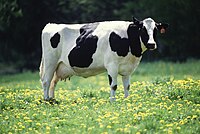
Photo from wikipedia
Milk fat globules (MFGs) are the major source of energy for infants' dietary intake. In this study, the effects of changes in the structure and composition of MFG after dairy… Click to show full abstract
Milk fat globules (MFGs) are the major source of energy for infants' dietary intake. In this study, the effects of changes in the structure and composition of MFG after dairy processing on lipolysis and immune regulation were investigated. Pasteurized MFG tends to form protein aggregates to prevent lipolysis. However, the aggregate is rich in neutrophil degranulation products, which are effective in killing pathogens. Homogenized MFG has the lowest hydrolysis rate due to the reconstituted anti-lipase barrier and exposed apolipoprotein. Simultaneously, the reconstituted barrier can compensate for the lack of the complement cascade. Spray-dried MFG had the highest hydrolysis rate attributable to the disrupted MFG barrier and the release of lipoprotein lipase and endothelial lipase. The immunomodulatory properties of spray-dried MFG proteins are mainly mediated by the toll-like receptor (TLR) signaling pathway. This research provides the improvement basis of dairy processing and functional infant formulas.
Journal Title: Journal of agricultural and food chemistry
Year Published: 2021
Link to full text (if available)
Share on Social Media: Sign Up to like & get
recommendations!